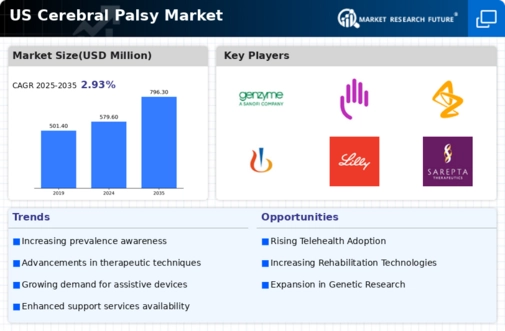The US Cerebral Palsy Market is evolving in a competitive landscape marked by ongoing advancements in therapeutic options, innovative technologies, and a growing focus on personalized healthcare solutions. This market is fueled by a significant prevalence of cerebral palsy and increased awareness about the condition, leading to rising demand for effective treatments. Providers are continually striving to improve patient outcomes, prompting collaborations and partnerships among healthcare stakeholders, including pharmaceutical companies, research organizations, and advocacy groups. The market's competitive nature has also led to an influx of research and development activities aimed at exploring new treatments and improving existing protocols.
As the market matures, companies are adopting various strategies to differentiate themselves, including the expansion of their product portfolios, investment in clinical trials, and the formation of strategic alliances.
Genzyme has established a notable presence in the US Cerebral Palsy Market, primarily through its commitment to developing innovative treatments that address the unique challenges associated with the condition. The company has capitalized on its extensive expertise in biotechnology to create specialized therapies that enhance mobility, ease pain, and improve the quality of life for affected individuals. Genzyme's strong reputation in the market is further supported by its robust pipeline of products aimed at treating neurological conditions.
With a focus on providing tailored care to patients, Genzyme has built a comprehensive support network that fosters collaboration between healthcare providers, caregivers, and patients, ensuring consistent and effective treatment delivery. Moreover, Genzyme's strong relationships with patient advocacy groups reinforce its standing in the market, as these partnerships further enhance its ability to reach and serve individuals living with cerebral palsy.
Bristol Myers Squibb has made significant contributions to the US Cerebral Palsy Market, focusing on innovative drug development and comprehensive treatment solutions. The company’s key products cater to the complexities of cerebral palsy, providing therapies that address muscle spasticity and related symptoms. Bristol Myers Squibb's strengths lie in its diverse portfolio, which includes both established and novel therapeutic agents that offer patients a range of treatment options. The firm's solid market presence is bolstered by extensive research capabilities and strategic mergers and acquisitions that have enhanced its focus on neurological disorders.
These initiatives have positioned Bristol Myers Squibb as a key player in the market, enabling it to leverage combined expertise and resources to advance treatment modalities. Additionally, the company's commitment to ongoing clinical research underscores its dedication to finding innovative solutions that can improve the lives of individuals with cerebral palsy across the United States.






















